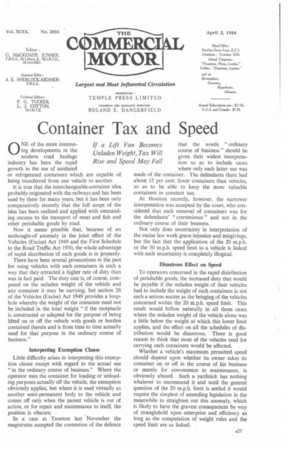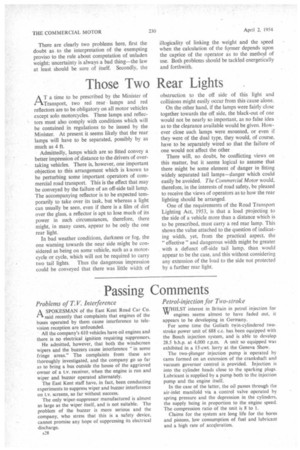Container Tax and Speed
Page 29

Page 30

If you've noticed an error in this article please click here to report it so we can fix it.
NE of the more interesting developments in the modern, road haulage industry has been the rapid growth in the use of insulated or refrigerated containers which are capable of being transferred from one vehicle to another.
It is true that the interchangeable-container idea probably originated with the railways and has been used by them for many years, but it has been only comparatively recently that the full scope of the idea has been realized and applied with outstanding success to the transport of meat and fish and other perishable goods by road.
Now it seems possible that, because of an unthought-of anomaly in the joint effect of the Vehicles (Excise) Act 1949 and the First Schedule to the Road Traffic Act 1930, the whole advantage of rapid distribution of such goods is in jeopardy.
There have been several prosecutions in the past for using vehicles with such containers in such a way that they attracted a higher rate of duty than was in fact paid. The duty rate is, of course, computed on the unladen weight of the vehicle and any container it may be carrying, but section 26 of the Vehicles (Excise) Act 1949 provides a loophole whereby the weight of the container need not be included in the total weight "if the receptacle is constructed or adapted for the purpose of being lifted on or off the vehicle with goods or burden contained therein and is from time to time actually used for that purpose in the ordinary course of business."
Interpreting Exemption Clause Little difficulty arises in interpreting this exemption clause except with regard to the actual use "in the ordinary course of business." Where the operator uses the container for loading or unloading purposes actually off the vehicle, the exemption obviously applies, but where it is used virtually as another semi-permanent body to the vehicle and comes off only when the parent vehicle is out of action, or for repair and maintenance to itself, the position is obscure.
In a case at Taunton last November the magistrates accepted the contention of the defence that the words "ordinary course of business" should be given their widest interpretation so as to include cases where only such latter use was made of the container. The defendants there had about 15 per cent, fewer containers than vehicles, so as to be able to keep the more valuable containers in constant use.
At Honiton recently, however, the narrower interpretation was accepted by the court, who considered that such removal of containers was for the defendants' " convenience " and not in the ordinary course of their business.
Not only does uncertainty in interpretation of the excise law work grave injustice and misgivings, but the fact that the application of the 20 m.p.h. or the 30 m.p.h. speed limit to a vehicle is linked with such uncertainty is completely illogical.
Disastrous Effect on Speed To operators concerned in the rapid distribution of perishable goods, the increased duty that would be payable if the unladen weight of their vehicles had to include the weight of such containers is not such a serious matter as the bringing of the vehicles concerned within the 20 m.p.h. speed limit. This result would follow naturally in all those cases where the unladen weight of the vehicle alone was a little below the weight at which this lower limit applies, and the effect on all the schedules of distribution would be disastrous. There is good reason to think that most of the vehicles used for carrying such containers would be affected.
Whether a vehicle's maximum permitted speed should depend upon whether its owner takes its container on or off in the course of his business or merely for convenience in maintenance, is obviously absurd. Such a yardstick has nothing whaiever to recommend it and until the general question of the 20 m.p.h. limit is settled it would require the simplest of amending legislation in the meanwhile to straighten out this anomaly, which is likely to have the gravest consequences by way of stranglehold upon enterprise and efficiency as long as the computation of weight rules and the speed limit are so linked. There are clearly two problems here, first the doubt as to the interpretation of the exempting proviso to the rule about computation of unladen weight; uncertainty is always a bad thing—the law at least should be sure of itself. Secondly, the illogicality of linking the weight and the speed when the calculation of the former depends upon the caprice of the operator as to the method of use. Both problems should be tackled energetically and forthwith.








































































































